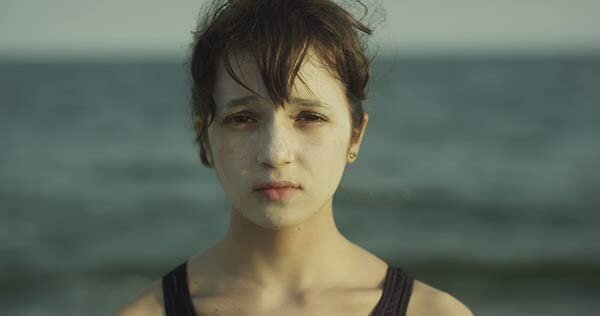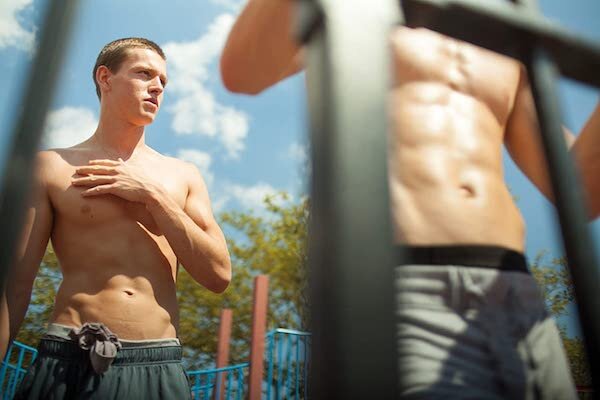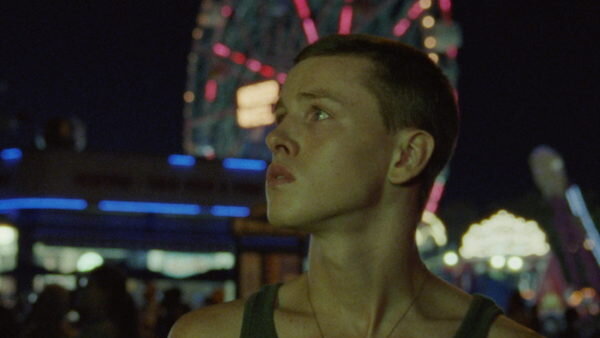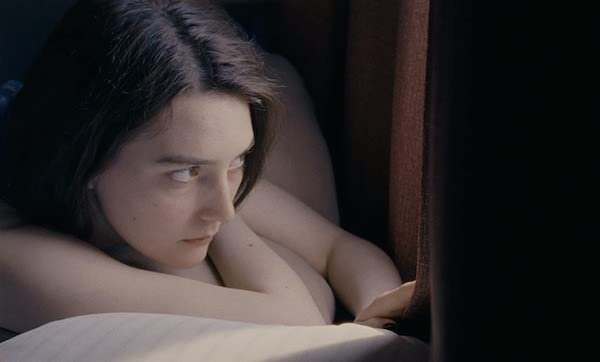Across just three features, Eliza Hittman has cemented herself as an incomparable presence in American independent cinema. Her young characters wrestle with intense feelings, and such heat manifests physically, too. Across It Felt Like Love, Beach Rats and Never Rarely Sometimes Always, Emily Maskell writes on Hittman’s tactile fascination and exploration of the human body, closing in on the details of our skin.
In The Skin of Film, renowned film theorist Laura Marks defines haptic visibility as “The way vision itself can be tactile, as though one were touching a film with one’s eyes.” The visceral quality of an image, according to Marks, can cross the binary of screen and viewer. It is at this precise intersection of the tactile and the intimate that Eliza Hittman’s films situate themselves. The filmmaker isolates the sense of touch; shots of fingertips tracing over bones, grains of sand sticking to skin, and shoddy stick-and-poke tattoos are captured in intently close detail. Hittman’s narratives foreground a haptic, non-verbal form of communication. The characters’ desire to grow comfortable in their skin is visible through the value placed on touch, with movements framed so tightly that the gritty texture of the pale-skinned protagonists’ skin fills the entire screen.
Hittman’s debut, It Felt Like Love sees 14-year-old Lila crave affection and touch from another person. Spending the summer third-wheeling her friend Chiara’s relationship, Lila’s eyes naturally come to rest on the bodies that surround her. Using a shallow focus, the camera sees through Lila’s eyes; her gaze flickers over hands, arms, shoulders, legs, torsos, fingertips. Narrow shots isolate body parts so much that the subject of this intimate framing is only clear in later, wider frames. Such restricted shots are prominent in moments cloaked by Lila’s desire. After Sammy, a friend of a friend she doesn’t know yet is fixated on, agrees to spend an afternoon with her and they walk to a nearby lake. Lila watches as Sammy wades into the water to cool off. She clings to reeds in a panicked bout of sexual desire while standing frozen by her shyness, as he strips off his tank top. Hittman stays trained on Lila’s hands, her white-knuckle grip the result of witnessing Sammy’s bare skin. When filming the male body, Hittman’s camera is voyeuristic and in Lila’s vision, bodies are sculpted erotically. When Sammy cuts his foot in the water, the gash mesmerises Lila and she watches intently as he bandages the wound. The cut is an opening for intimacy: Sammy’s thick skin has been breached and Lila follows him home in a moment draped with heated tension. Close-ups of tattoos and low-cut vests show exactly where Lila’s interest lies.
The baring of male skin is once again apparent in Hittman’s sophomore film, Beach Rats. With a wardrobe of tank tops and gold chains, 19-year-old Frankie flits between displaying hyper masculinity around his friends, and raw vulnerability with the men he encounters online. The desire for the physicality of another body is a longing he represses; creeping tension manifests as he follows the back of a stranger’s head towards the beach. Drifting in and out of focus, they hastily remove their clothes, lips tantalisingly close but never touching. Baring himself physically, but not emotionally, Frankie lets his wandering eyes and curious fingertips glide over skin, in search of a release he’s afraid of, but desperate for. Extreme close-ups capture him chasing pleasure with fingernails scratching scalp, pulsing muscles, and the jutting curve of his Adam’s apple. There is purposefulness in Hittman’s closeness, replicating the intimate connection that Frankie craves and rejects simultaneously. Shots entirely encompassed by skin glistening with sweat are so close it becomes impossible to know which body belongs to who. Frankie’s rippling muscles dissolve into ocean waves, while his broad shoulders slump into the sand dunes. His body is the vessel for a performance of toxic masculinity where violence is self-prophesied, and Hittman peels back the plaster covering Frankie’s bruised masculinity. Not even salt water can clean the wounds of Frankie’s growing pains.
The beaches of Brooklyn are essential in both It Felt Like Love and Beach Rats. An space for the liberation of skin; bikinis and swim shorts expose pale torsos to be warmed by the sun. Shot on 16mm film, skin has a granular quality, reminiscent of the sand the bodies lie on. A melding of body and landscape makes skin the environment that Hittman’s roving camera travels across. The thunderous ocean calls both Lila and Frankie to shore, present from It Felt Like Love’s opening shot in which Lila stands on the beach, staring straight into camera, her face slathered in a thick layer of ghostly white suncream. The naked surface of her skin is protected, shielding her from both the sun and the hot gazes of her peers. In Beach Rats, the beach is Frankie’s playground for experimentation and violence. Harris Dickinson's performance as Frankie is inherently physical, as he is often without a shirt underneath the midday sun, his physique is surveyed with proximity. Moonlight casts a muted black and white shadow onto beach scenes at night. This low light abruptly contrasts with Frankie’s skin under the neon lights of a fairground, where the bright colours dance across his body illuminating a more vibrant side to the young man. Frankie’s body reflects his surroundings; be it the dark marks of his damaged masculinity or his skin illuminated under multi-coloured light, as he wrestles with his sexuality.
Bodies framed as vulnerable entities are common to Hittman’s work, but never more apparent than during scenes in doctors’ surgeries. While Beach Rats doesn’t depict young women and medical institutions, such scenes in Hittman’s other two features are vital. The skin of Hittman’s female characters comes under intense biological examination in It Felt Like Love and this year’s Never, Rarely, Sometimes, Always. Anxiety radiates from Lila as, after she tells Chiara that the house party she went to the night before was a blur, she admits herself to a clinic for emergency contraception. She scrunches her eyes and shudders into her pronounced collarbones while her body is assessed. Lila warily answers questions about her sexual activity in a moment that mirrors a pivotal scene in Never, Rarely, Sometimes, Always. Confronting an unwanted pregnancy at 17, Autumn requires parental consent to terminate the pregnancy in the state of Pennsylvania. Hittman swaps the crashing of Brooklyn’s ocean waves for the screeching sound of the subway, as Autumn and her cousin Skylar reach the Planned Parenthood clinic in New York City. Autumn struggles to relate to the changes in her body. Bodily autonomy becomes a priority more than ever, with the stretching of her skin disrupting her independent identity. The manipulation of her body beneath the surface results in destructive action: standing in front of a mirror, staring at her reflection, Autumn punches her own stomach. This moment is framed from a distance and it is only later, in the New York clinic, that close-ups of the blooming bruises are exposed during an ultrasound. The lingering marks are a reminder of a future she doesn’t want. In another moment Autumn finds Skylar reuniting with a young man they met on the bus to New York, he repeatedly makes advances on Skylar until she kisses him. Skylar’s uncomfortable grimace fills the screen, Autumn reaches for her cousin’s hand to hold, they lock fingers in a pinky promise of protection. Their bare skin touches, this seemingly more distant connection lingered on more closely and intimately than the kiss.
Hittman’s camera roams over Lila, Frankie, and Autumn’s bodies with a delicacy that frames exposed skin as blank pages, ready for stories to be written on. Designing frames you can feel against your own skin, Hittman uses haptic visibility to bridge the divide between viewer and screen. Fingertips up your arm, the ocean breeze whipping against your ears, an aching bruise that thrums with the muted pain of youth.
Emily Maskell (@EmMaskell) is a freelance film writer. Em is based and studies film in London. She is a staff writer for Flip Screen with bylines for Little White Lies, NME, The Quietus and more.





